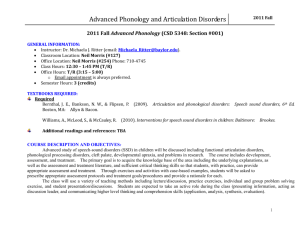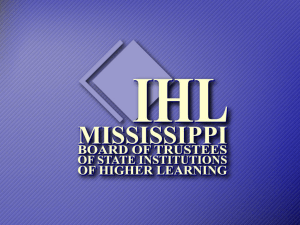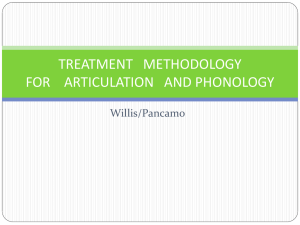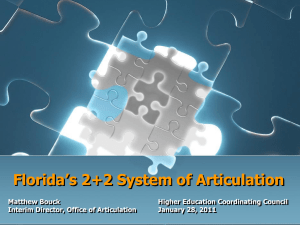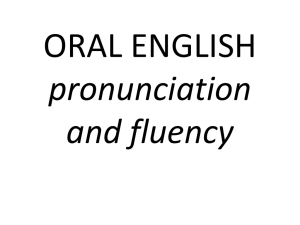CSD 3308-01 Articulation
advertisement
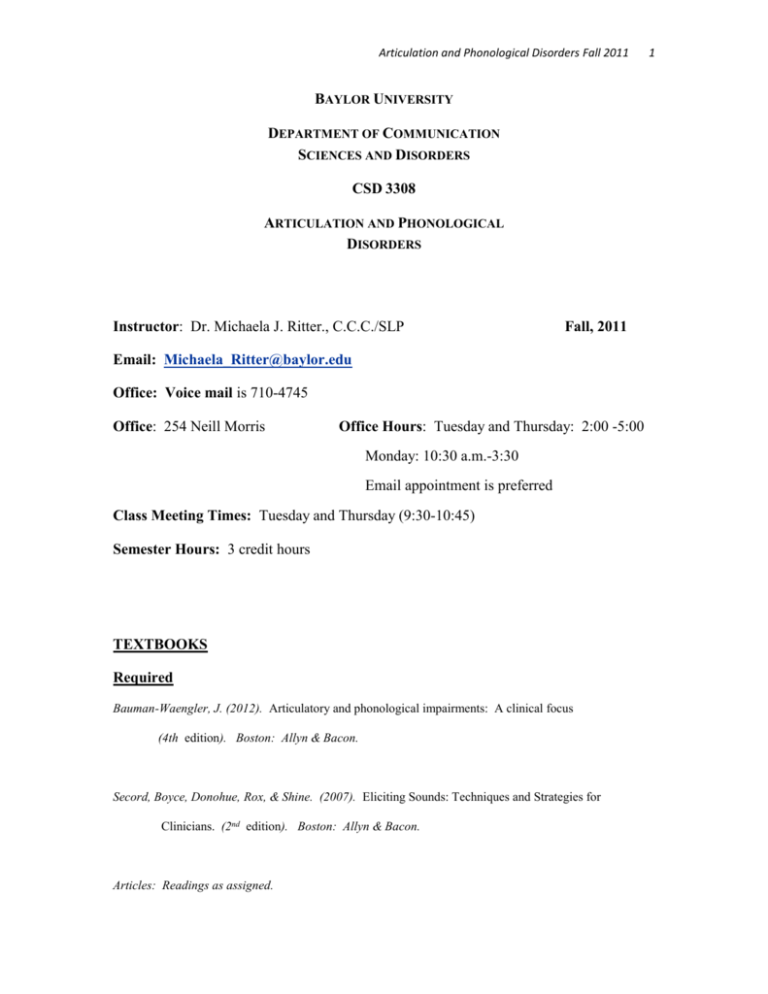
Articulation and Phonological Disorders Fall 2011 BAYLOR UNIVERSITY DEPARTMENT OF COMMUNICATION SCIENCES AND DISORDERS CSD 3308 ARTICULATION AND PHONOLOGICAL DISORDERS Instructor: Dr. Michaela J. Ritter., C.C.C./SLP Fall, 2011 Email: Michaela_Ritter@baylor.edu Office: Voice mail is 710-4745 Office: 254 Neill Morris Office Hours: Tuesday and Thursday: 2:00 -5:00 Monday: 10:30 a.m.-3:30 Email appointment is preferred Class Meeting Times: Tuesday and Thursday (9:30-10:45) Semester Hours: 3 credit hours TEXTBOOKS Required Bauman-Waengler, J. (2012). Articulatory and phonological impairments: A clinical focus (4th edition). Boston: Allyn & Bacon. Secord, Boyce, Donohue, Rox, & Shine. (2007). Eliciting Sounds: Techniques and Strategies for Clinicians. (2nd edition). Boston: Allyn & Bacon. Articles: Readings as assigned. 1 Articulation and Phonological Disorders Fall 2011 2 Course Description This course is designed to provide students a basic foundation in the prevention, assessment and treatment of articulation and phonological disorders in children. Students will initially learn foundational information related to the speech sounds of English, the anatomical-physiological mechanisms of speech production, and the normal development of speech. Students will learn about various aspects of articulation and phonological disorders, such as variables that are associated with the disorders, the role of dialects, and the differences between the different kinds of speech production disorders. Link to American, Speech, Language, and Hearing Association (ASHA) Knowledge and Skills Acquisition (KASA): http://www.asha.org/uploadedFiles/certification/KASASummaryFormSLP.pdf The ASHA KASA document details the Standards for the Certificate of Clinical Competence for SpeechLanguage Pathologists (CCC-SLP). This document is utilized to demonstrate compliance with accreditation related to preparing students to meet ASHA certification requirements. According to the ASHA KASA, the Learning Outcomes for this course are as follows: LEARNING OUTCOMES The student will: 1. List and describe the structural (anatomical--physiological) mechanisms of speech production. (Standard III-C) 2. Demonstrate knowledge of the principles of articulatory phonetics and phonology and the expertise in phonetic transcription necessary to transcribe and analyze speech and to develop phonological intervention plans based on such analyses. (Standard III-C) 3. Demonstrate knowledge of basic definitions of articulation and phonology (Standard III-C) 4. Demonstrate knowledge of normal articulatory-phonological development in children, including listing of major milestones (Standard III-B) 5. Demonstrate the knowledge of the nature of specific articulation and phonological disorders and differences. (Standard III-C) 6. Explain models and theories of articulatory-phonological development and disorders in children. (Standard III-C) 7. Explain the concept of articulation differences vs. disorders in children and adults who speak English as a second language. (Standard III-C) 8. Demonstrate knowledge of the collection of information crucial to the assessment of children’s speech, including connected speech samples, articulation tests, minimal pair tasks, etc. (Standard III-D) 9. Demonstrate knowledge of the principles and methods of prevention, assessment, and intervention of children with articulation and phonological disorders. (Standard III-D) Articulation and Phonological Disorders Fall 2011 3 10. List and describe intervention principles and currently-used clinical techniques for the planning and implementation of intervention plans for children with developmental articulatory-phonological disorders. (Standard III-D) 11. Demonstrate knowledge of normal and abnormal patterns of development and the characteristics that can distinguish one from the other. (Standard III-D) STUDENTS WITH SPECIAL NEEDS If you have any special learning needs, please see me during the first week of class so we can be sure you get the proper accommodations. However, before seeing me you must first register with the Office of Access and Learning Accommodation (OALA) (http://www.baylor.edu/oala). OALA: 254-710-3605 Baylor Blackboard: Syllabus, lecture notes, handouts, special announcements, and other class material will be posted on the Blackboard. The student should become familiar with the BB as quickly as possible. Inability to retrieve course information will not be an acceptable excuse for failure to acquire/master the information. If you are registered for the class then you are automatically linked to the course. You will need to check the course site at least once daily. ACADEMIC INTEGRITY Students in this course are expected to firmly abide by the Baylor University Student Honor Code as outlined in the Student Handbook. Students who violate the Honor Code will suffer the consequences: Any evidence of dishonorable conduct (i.e., cheating in and out of the class for class activities such as exams and projects) as outlined in the Baylor Honor Code will result in at least an "F" in this course (http://www.baylor.edu/honorcode/index.php?id=44060). All Honor Code violations will be reported to Baylor University’s Office of Academic Integrity right away throughout the semester and will follow the student through their entire time at the university. Please guard your ethical reputation beginning now. All books/notes/electronic devices must be out of sight during exams. All hats/caps must be removed. Articulation and Phonological Disorders Fall 2011 4 COURSE REQUIREMENTS 1. Class participation:: You are expected to attend class and participate in discussions and activities. I anticipate that you will do all assigned readings. All readings should be completed before class on the day they are to be discussed. Please remember that lectures will be much easier to follow if you have read the day's assignment BEFORE you come to class. I suggest that you do the following: 1. Before class, read the reading(s) and highlight important information. 2. Attend class, hear the lecture. 3. After class, re-read the reading(s). 1I. CSD Major – Attendance Policy: The attendance policy of the College of Arts & Sciences states: “To earn course credit in the College of Arts and Sciences, a student must attend at least 75% of all scheduled class meetings. Any student who does not meet this minimal standard will automatically receive a grade of ‘F’ in the course.” As a CSD Major, you are basically expected to attend all classes. In the event you are unable to attend a class session, it is your responsibility to obtain (a) class notes and/or handouts from another student, and (b) any changes in the class schedule. You are also expected to take tests on time. If you are ill, it is your responsibility to notify the instructor prior to the time of the test. If you miss a test without prior approval from your instructor, you will be subject to receiving a zero for the test. When returning from the illness, it is the student’s responsibility to take the makeup exam within 3 days or the student will automatically receive a zero for the test. III. Quiz Fun 3: There will be three in-class quizzes. These quizzes will be based on the assigned readings and/or class discussions/activities. (10% of total grade) IV.: Exams 4: There will be three in-class exams plus the final examination. These exams will be based on assigned readings and class discussions/activities. (80% of total grade) Exam 1 (20%) 100 points possible Exam 2 (20%) 100 points possible Exam 3 (20%) 100 points possible Exam 4 (final exam) (20%) 100 points possible Articulation and Phonological Disorders Fall 2011 5 4. Application Project: Articulation /Phonological Cards: A 5 by 8 card system (10% of total grade) A. Articulation Cards 100 points possible I. Required Cards: 3 sets of Articulation Cards A. Set 1: /s/ (32 cards) plus activity materials included B. Set 2: /r/ (32 cards) plus activity materials included C. Set 3: /l/ (32 cards) plus activity materials included II. Each Set of Articulation Cards must contain: a. 10 picture cards of the initial sound in words b. 10 picture cards of the final sound in words c. 10 picture cards using clusters in words d. ONE card with stated LTG and STGs to be used with each set of Articulation Cards (goals and activities selected must match) e. One activity card to be used with each set of Articulation Cards f. Materials needed for the selected activity (ready to use in therapy) g. Activity and materials will be presented in class (3-5 minute presentation) III. Specific Directions: 1. MUST use 5X8 Note Cards for this assignment 2. Find a picture or photo of the targeted stimuli (or picture card) 3. Place the picture or photo on a 5 by 8 card Note Card 4. Type or print the word under the picture on each card 5. On an additional card: Type out your goals to be addressed and used as part of your weekly plan for each set of articulation cards. 6. On an additional card: Type out a complete description of an activity to be used with the set of articulation cards (1 card per set of articulation cards). Articulation and Phonological Disorders Fall 2011 7. Make and bring all materials and directions needed for this activity. The ready to use materials must accompany the set of articulation cards. 8. Activity and materials will be presented in class (3-5 minute presentation) 9. Laminate your cards (preferred): bonus points 6 10. Cards will be expected on due date only. Cards must be placed in a box or container of your choice. This will be your organization tool. 11. Must be organized: A. Initial together of targeted sound B. Final together, etc. C. Clusters together D. The Goal card should be placed at the beginning of each set of cards. E. The Activity card should be placed at the back of each set of cards. F. The complete set of materials to be used as part of the activity must be included (i.e. book, game board, tokens, fish net, magnets, artic bingo cards, etc.). Materials will be presented to the class on the listed due date. ***LATE ASSIGNMENTS/TESTS--10 POINTS LOST PER DAY GRADING CRITERIA 93-100 A 90-92 A88-89 B+ 80-87 B 70-80 C 60-69 D Below 59.5 F Articulation and Phonological Disorders Fall 2011 7 COURSE OUTLINE Course Outline/Schedule WEEK TOPIC READINGS Syllabus Review 1 August 23 2 August 29 3 September 6 Assignments Syllabus *Review of key terminology and concepts in phonetics, phonology, and articulation Chapter 1 Terminology, Phonetics versus Phonemes: Clinical Implications Chapter 1 and 2 Articulatory Phonetics: Speech Sound Form Vowels and consonants Assigned readings: Secord Quiz 1: Chapter 1 (September 8) Chapter 2 Assigned readings: Secord 4 Phonetic Transcription and Diacritics Chapter 3 & Secord September 13 5 September 20 6 September 27 Exam 1: September 20 (Tuesday) Exam 1: September 20--Ch 1-3 & class notes) Begin Chapter 4: Theory Chapter 4 Theory: Phonology Assigned readings: Secord Chapter 4 Set I: Artic Cards (September 29th ) Articulation and Phonological Disorders Fall 2011 7 October 4 Quiz 2 over Chapter 4 Quiz 2: (Chapter 4)—October 6th Ch 5--Normal Phonological Development Chapter 5 8 Chapter 5 8 Ch 5--Normal Phonological Development October 11 9 October 18 Exam 2: Chapters 4 and 5 and notes Exam 2: October 18th Ch 6—Begin Appraisal: collection of data Chapter 6 Ch 6: Appraisal: collection of data Chapter 6 Articulation Tests Secord’s text: readings Spontaneous speech sample Set 2 due October 25th: Articulation Cards Ch 8: Begin Diagnosis: Phonetic versus Phonemic Chapter 8 Goal writing/Treatment Plan Exam 3 (chapters 6 and 8 and class notes)— November 8 10 October 25 11 November 1 12 November 8 Ch 9: Begin Therapy for Articulation Errors Quiz 3 (November 3)—Chapter 6 and notes Chapter 9 Chapter 9 13 November 15 Therapy for Articulation Errors Therapy Sequence Set 3 due November 17th: Articulation Cards Articulation and Phonological Disorders Fall 2011 14 Therapy for Articulation Errors November 22 Treatment of Phonemic Errors 9 Chapter 9 and 10 & Secord 15 Dialects and English as a Second Language Chapter 7 Specific Disorders and Differences Chapter 11 November 29 16 December 1 December 6 and 7 Last Day of class Study Days No classes meet Final Examination: Final Exam *8, 9, 10 plus class notes and readings Final Exam Tuesday, December 13th, 2pm-4pm December 13

